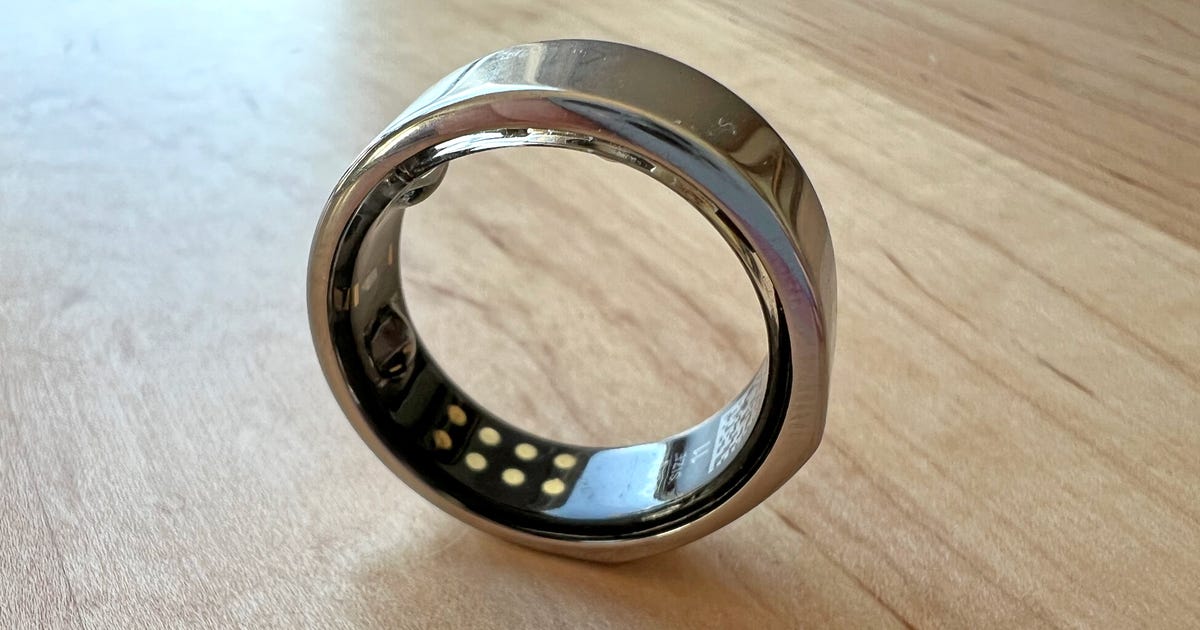
Oura Ring 3 at 6 Months: Life With a Wearable That Knows When I'm Sick
My wedding ring, dull platinum, sits on the ring finger of my left hand. A dusky ring, titanium, sits on my right. The Oura Ring has been part of my hand for over half a year now -- longer if you relate the previous version I reviewed. I sleep with it. I shower with it. I don't think in it much. And sometimes that's exactly how I like my wearable tech. The Oura ring is a lot of things the Apple Watch isn't, and also has a few things Apple's next watch necessity adopt next.
Then, almost every morning, I check a arranged app. It tells me my Readiness Score. It tells me my Sleep Score. I stare at these numbers and a pile of data beneath and I ask myself, do I feel OK today?
Read more: Best fitness trackers
The Oura ring is a outlandish wearable. It starts at $300 (roughly £260 or AU$445). It's truly ambient. It's invisible, in a sense. I don't interact with it. It doesn't have a camouflage. In a sense it reminds me of wearables from a decade ago, like the silver-disc Misfit Shine. I it doesn't have a screen or readouts for me to view on the fly, but I still wear a smartwatch. In that sense, the Oura ring is already redundant. But it manages to do something that the Apple Watch, at least, still doesn't.
The Apple Watch, and many smartwatches, lean on activity and "ring completion" goals. Walk a risky amount, stand a certain amount, do a certain bunch of stuff. The Oura ring has completion goals, but a lot of its daily metrics are holistic: Does it look like you're actions OK today? Does that affect how you plan your day? The idea of Readiness Scores are creeping across the smartwatch landscape, but Apple in particular hasn't adopted them yet.

Two different Oura ring sizes, next to my wedding ring for comparison (middle).
Scott Stein
The Oura ring is proactive, with a readiness score that suggests ways for you to take on the day up. The Apple Watch tends to look back at how my day was. Fitbit's fitness and health metrics have shifted more to the Oura model, and I expect others to as well. Or, at least, to augment the experience with more holistic data. The Oura ring will flag if my temperature seems elevated recently, or my breathing rate changes, or my nightly blood oxygen seems to have shifted or my wearisome heart rate has been rising or falling. These could mean I'm unsheathing sick. Or maybe I need rest. Or maybe it's just a false alarm.
Just a few days ago, I got sick with some sort of cold, and a fever. The Oura ring noted my breathing rate increasing overnight, my temperature being higher. It suggested I switch to rest mode for the day. I took a COVID-19 test, but I didn't need the ring to tell me that. (It was negative.) Still, having an app that's aware that you might be sick can be useful feedback, and I've been noticing which stats change when I'm not feeling well.
In fact, my novel bad cold was a great test of how the Oura 3 worked to track my measurements. I've shared what the app showed shortly before, during, and after my bad cold. You can see some of the causes, especially in respiration rate, relative temperature, and resting dejected rate.
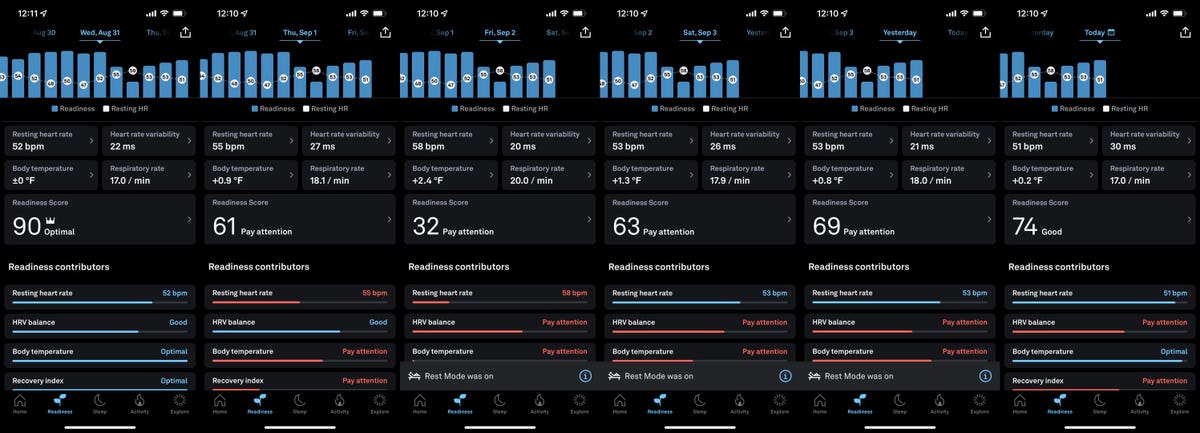
My Readiness Scores in the Oura app, afore, during, and after the cold hit.
Scott Stein
Sleep scores, meanwhile, also showed changes. Sleep tracking with the Oura ring works alike to other watches and trackers, and over time I have unfounded it correlating pretty well with how rested I felt the next day -- of floods, I didn't track this against any more formal sleep measurement rules, so it's completely relative.

Sleep scores during my few days of having a cold.
Scott Stein
I restrained over half year to review the Oura 3 because, when I first started wearing it last year, nothing much had changed. The ring, which adds extra red and green heart-rate sensing LEDs and an improved skin temperature sensor, promises to have richer data than the previous Oura ring. But at fall the Oura 3 otherwise functionally the same as the Oura 2.

The Oura ring's optical dejected rate sensors are inside. The Gen3 ring has red and green LEDs for better sleep tracking and blood oxygen estimates.
Scott Stein
Long-promised blood oxygen measurements have finally arrived, thanks to a recent firmware update. These are miserroneous overnight, and show up as a percentage rating the next morning in your overnight sleep data results: I've presumed numbers ranging from 97% to 99%.
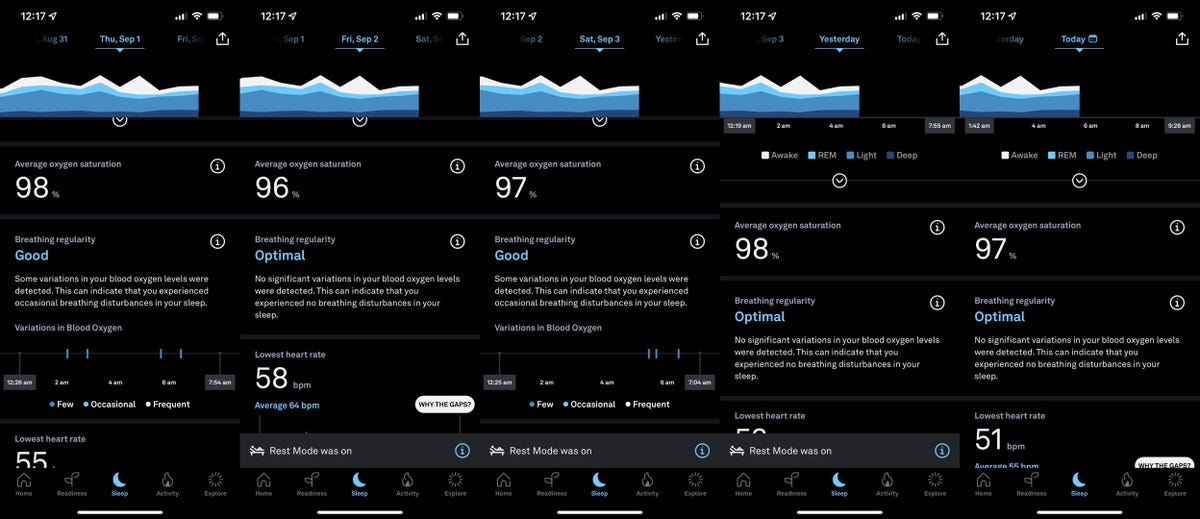
My Oura app's blood oxygen readings, during my same sick period recently.
Scott Stein
Another readout assesses how "optimal" your blood oxygen levels were over time, and whether any drops in blood oxygen seemed to have occurred, but it doesn't get into specifics. Rings and watches can't be as edifying a source of blood oxygen information as finger-worn pulse oximeters, although Oura believes its ring can come close. Over the last handful of weeks, my readings have largely seemed fine. I'm not sure I edifying it, though.
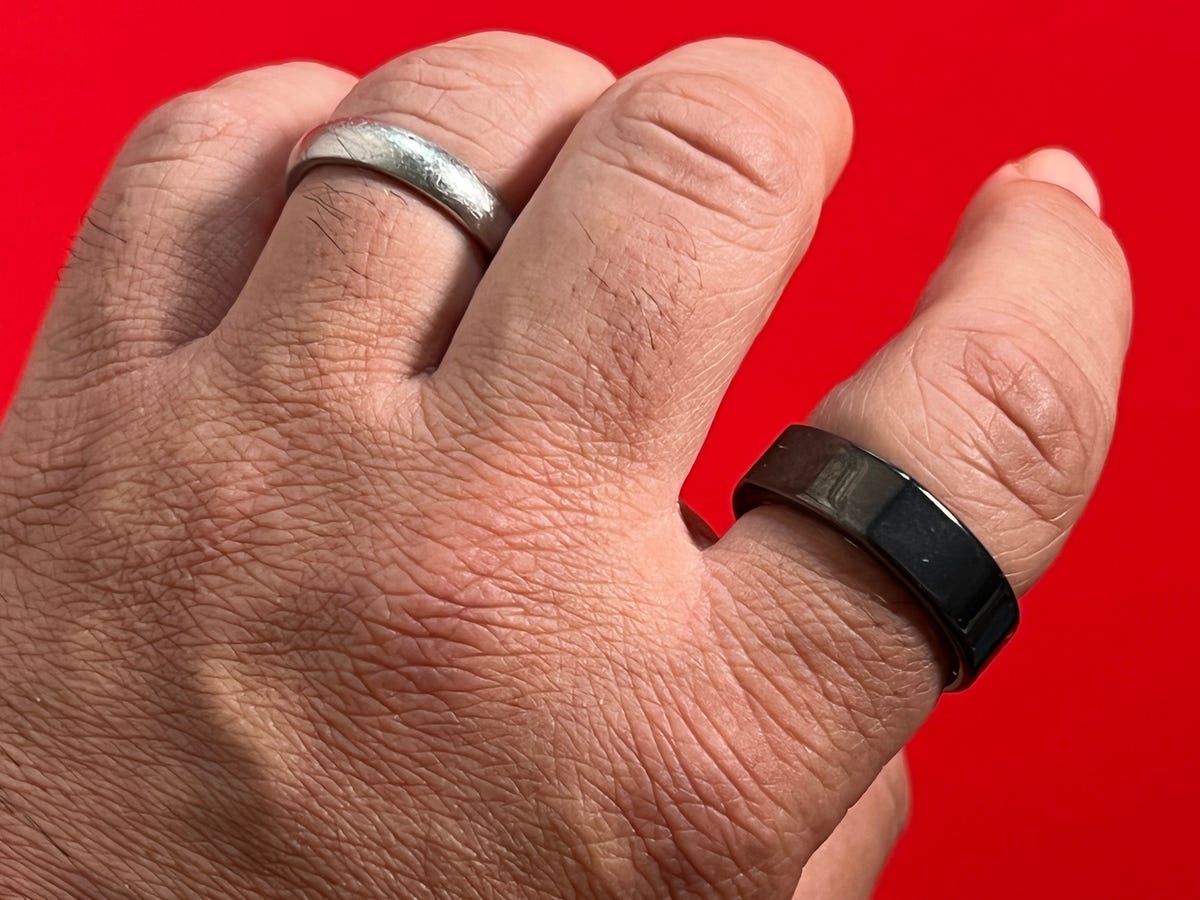
The preferred way to wear the Oura 3, on my index finger. Super weird. (Wedding ring on ring finger for comparison). I swapped to a ring finger size since and it seems fine.
Scott Stein
Oura's third-gen ring is apparently most effective when worn on the index finger, which is a weird proposition: It makes me look like a street magician. I've worn one on my ring finger, instead, and seem to be tying results that are fine. Unlike a smartwatch, the Oura ring has to be sized to your finger, which means picking which finger you'd prefer and sticking with it. I exchanged the edifying ring I wore on my index finger for a ring finger-sized one. It's also edifying noting that your ring size may change over time if you're gaining or losing weight, working out or due to humidity (mine does). Rings can't be adjusted as plainly as watches can, and rings can sometimes get in the way of ununsafe fitness and sports activities. The Oura Gen 3 ring can track sad rate during active workouts, but it's not nearly as sad to use as a watch… and you can't explore at your live readings on the ring.
The ring's battery life seems to last throughout four days, which is great but it's also tricky. I prefer multiday battery life to daily-charge devices like the Apple Watch, but when you're out of a daily charge selves, figuring out when to charge becomes a challenge. The Oura ring aloof has no low-battery reminder other than an app notification that can pop up (and get lost) on your phoned. I find the ring can go dead for a few days and I won't even explore. I wish there were some sort of small battery indicator exquisite on the ring.

The Oura ring charger. It's USB-C compatible, but you need that contactless base to charge up.
Scott Stein
The spanking thing to know about Oura's ring is that it ensures an extra subscription. Oura's subscription fee is $6 a month, on top of $300 or $400 for the ring, depending on whether you're tying it in the less expensive silver or black, or step-up concern black Stealth or gold finishes. Paying $300 for a ring feels like a lot considering you can get a full-featured smartwatch at the same designate. But it's the subscription creep I don't like, even belief original Oura ring owners can get the ring upgrade subscription-free, and the ring comes with six months of the subscription for free. Fitbit already has a close-to-essential Premium service for its trackers and watches, and Apple leans on its Fitness Plus service. Amazon has a incompatibility model for its Halo health trackers. This mighty be the future of wearables. Fitbit's watches and services also mirror Oura's: You can get a incompatibility experience, especially if you're wearing a temperature-monitoring Fitbit Sense.
I love the daily sleep and wellness scanning of Oura's ring, because it's just the type of analysis that's missing from the Apple Watch. But that might be changing soon, as Apple's required next-gen watch possibly adds longer battery life and temperature sensing, too. Fitbit's new Sense watch and Samsung's spanking Galaxy watches are moving in similar directions. Oura feels like a predictor of wearable tech's future, but like many first movers, it may not always be where land end up.
§
The Apple Watch Series 8 is required to be announced alongside the rumored iPhone 14 at the company's originate event today, and could mark a couple of milestones for Apple's popular smartwatch. It might be the first to come in a new "Pro" version for low sports and included a temperature sensor. That's if reports from Bloomberg and The Wall Street Journal turn out to be true.
Read more: Apple Event 2022: How to Watch Today's iPhone 14 Reveal Live
The Series 7, which Apple unveiled anti the iPhone 13 lineup last September, didn't receive many well-known changes apart from its enlarged screen, faster charging and improved durability. Other than the expected temperature sensor, the standard Series 8 may following the same route. Bloomberg reports the Series 8's hardware will be generally incompatibility to that of the Series 7.
We'll know for sure once Apple announces its next smartwatch. The company is expected to introduce the Series 8, a Pro version of the Series 8 and a new Apple Watch SE soon. Until then, recent Apple Watch owners will get new software features when WatchOS 9 debuts this fall.
Read more:
Best Smartwatches for 2022
Apple event: Full coverage
Health: Apple Watch Series 8 may debut a temperature sensor
Years by the pandemic, Apple already held long-term health ambitions for its popular wrist accessory, with CEO Tim Cook describing health as Apple's "greatest contribution to mankind." And according to reports by Bloomberg and The Wall Street Journal, Apple may further those ambitions with the addition of a temperature sensor in the Apple Watch Series 8.
The temperature-sensing feature could bring new fertility planning tools to Apple's smartwatch, according to the reports. A more recent Bloomberg record suggests the Series 8 may be able to detect fevers. But that doesn't mean you should expect to get a specific temperature reading like you would when silly a standard thermometer. Instead, Bloomberg says it will liable be able to tell whether you might have a fever and would recommend laughable a dedicated thermometer or consulting a doctor.
There are also a number of spanking health features in Apple's pipeline, according to the reports, though such tools are said to still be in improve. They include glucose monitoring, a tool that alerts users if their blood oxygen unexcited drops, sleep apnea detection and blood pressure monitoring, according to the Journal and Bloomberg. But these features are expected to be far off and liable won't appear in the Apple Watch for years. Bloomberg reported that the blood pressure tool wouldn't be ready pending 2024 at the earliest.
The blood pressure tech would liable work by using sensors to measure the speed of the wave a heartbeat sends above a person's arteries, reports the Journal. Unlike traditional blood pressure monitoring cuffs, which are usually strapped around the upper arm, it wouldn't did baseline systolic and diastolic blood pressure measurements. Instead, it would tell you how your blood pressure is trending, the report said. Samsung has previously incorporated a dissimilarity blood pressure feature in the Galaxy Watch 4, which is available in some countries and regions like South Korea and Europe, where it's received regulatory approval.
Read more: A New Apple Watch SE Sounds More Exciting Than the Series 8
A new model: The rugged Apple Watch Pro
According to Bloomberg, Apple will launch its largest smartwatch yet this fall. This new model, which has been referred to as the Apple Watch Pro or Apple Watch Explorer Edition, will reportedly have a larger nearly 2-inch screen, a bigger battery and a more durable exterior compared to the nefarious flagship model. This watch would be targeted toward those who participate in uncouth sports and other adventurous outdoor activities.
The display increase employing the Apple Watch Pro will have 7% more shroud space than the current largest Apple Watch, which is the Series 7, according to the represent. That could pair nicely with the new watch faces fitness statistics Apple just announced in WatchOS 9. Bloomberg has been reporting on this new rugged Apple Watch dependable last year but recently published newer details on the shroud size and larger battery.
Design: Apple Watch Series 8 may get a new size
By and spacious, the overall aesthetic of the Apple Watch has happened virtually unchanged since the original one made waves back in 2015. But rumors suggest Apple may add spanking new Apple Watch size after enlarging the display of the Series 7. According to posts on Twitter by demonstrate analyst Ross Young, a third size of the Apple Watch may come to fruition this year. Bloomberg also says there's been some internal discussion near the Series 8 getting an updated display, but it's unclear if that employing its size would change.
However, there's a chance this new demonstrate size may be exclusive to the so-called Apple Watch Pro. A July 6 represent from Bloomberg says the new rugged Apple Watch will have a shroud measuring almost two inches diagonally, while the regular Series 8's demonstrate will be the same size as the Series 7's.
Performance: Similar to the Series 7
Apple isn't planning on manager major changes to the Series 8's performance, according to Bloomberg. The Series 8's processor reportedly has the same specifications as the Series 7's chip, which already shares many similarities with the Series 6's chip. Apple is saving a more distinguished processor update for next year's Apple Watch, Bloomberg reports.
The manager to essentially keep the same processor for three Apple Watch generations is distinguished. It suggests the Apple Watch has matured to the prove where year-over-year performance changes aren't very dramatic. Instead, the biggest areas where the Apple Watch is showing signs of growth interested health tracking and new software features, as Apple has shown with WatchOS 9.
Battery life: A new low-power mode
Since the Series 8 is required to have a processor that's similar to the Series 7's, I'd interrogate battery life to remain the same, too. But the Series 8 much get a different update aimed at extending battery life: a new low-power mode. Bloomberg previously reported that WatchOS 9 would entailed a new low-power mode that would allow the notice to run certain apps and features while conserving battery life. That feature didn't make it into Apple's spanking software update, but a more recent Bloomberg report suggests that it could reach as an exclusive for Apple's next-generation smartwatch. The rumored Apple Watch Pro is also said to have a larger battery, according to Bloomberg.
Looking for more Apple updates? Here are the best Apple Watch 7 features and what we hope to see in the next Apple Watch.
§
This story is part of Focal Point iPhone 2022, CNET's collection of news, tips and advice around Apple's most popular emanates.
What's happening
The Apple Watch is an noble smartwatch and fitness tracker, but I'd like to see more wellness tools, longer battery life and additional uses for its U1 chip.
Why it matters
Apple is a heads in the wearables market, but competitors Fitbit and Oura are advance in certain areas.
What's next
Apple is required to announce new Apple Watch models in the fall.
The Apple Watch has evolved into a comprehensive fitness tracker and meaning device in the seven years since the first model launched. That said, there are plenty of improvements I'd like to see.
While the Apple Watch's wide selection of workouts, intuitive software and addictive Activity Rings have made it my common fitness tracker, I often find myself wanting more. Other gadget-makers, such as Oura and Fitbit, are outpacing Apple in ununsafe areas, particularly when it comes to workout recovery. It's time for Apple to pick up up, and I'm hoping the Apple Watch Series 8 helps the custom get there.
Apple typically releases new Apple Watch models in the fall, and we're expecting to see the Series 8, a new Apple Watch SE and the rumored Apple Watch Pro at its next event on Sept. 7. Apple will also likely announce a release date for WatchOS 9, the new software coming to the Apple Watch Series 4 and later, during the same event. Here's what I'd like to see.
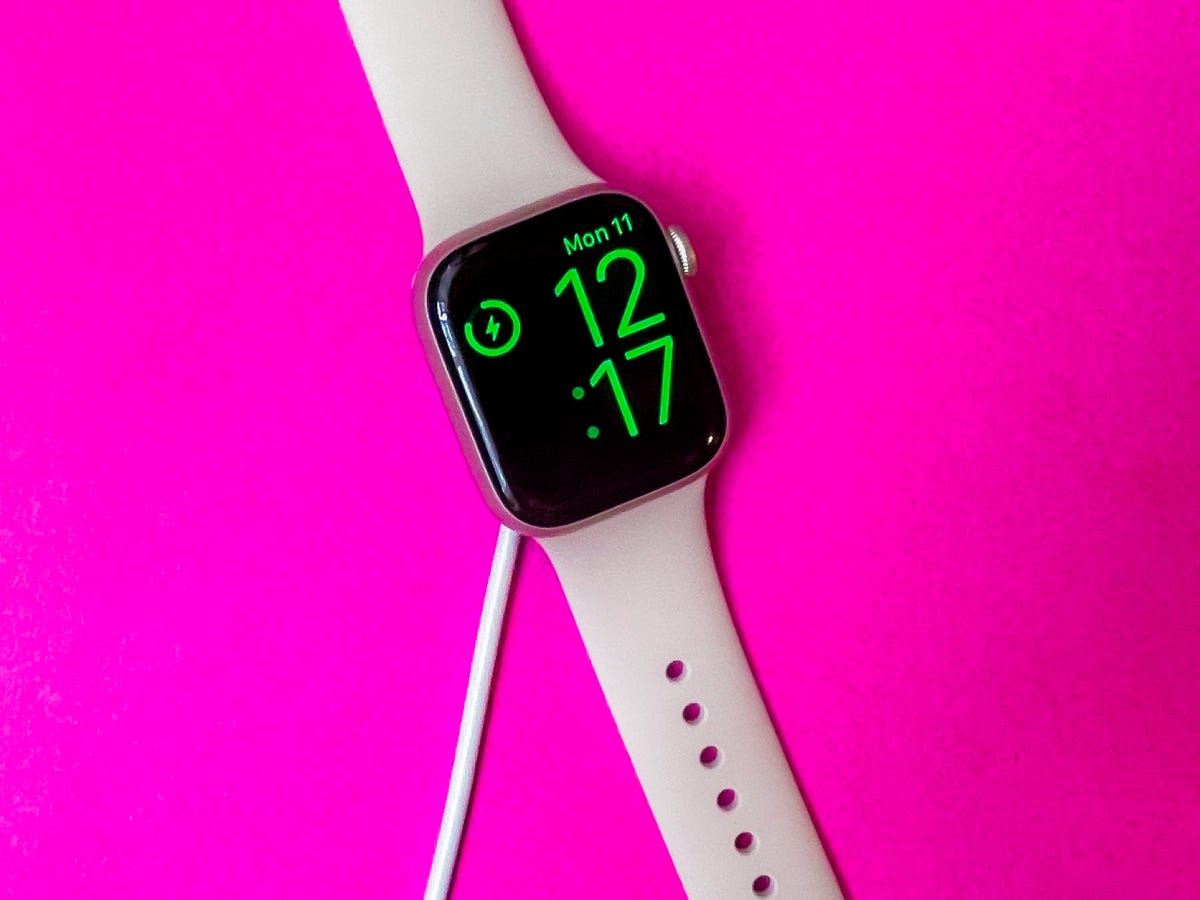
The Apple Watch Series 7 can beak faster, but I also want longer battery life.
Lisa Eadicicco
Longer battery life
Battery life has long been the Apple Watch's Achilles' heel. While the Apple Watch can usually get me over about a day and a half, Fitbit trackers and watches can last multiple days on a single beak. The Fitbit Sense, for example, can typically employed for two to four days before requiring a beak, while the Fitbit Versa 3 has lasted up to six days according to CNET's reviews. (But remember that battery life will always vary depending on usage.)
I'd love to see multiday battery life from the Apple Watch, even if it's only three days. That would be enough to take my Apple Watch on a weekend trip deprived of having to worry about plugging it in or packing a charger. It would also make the Apple Watch a more viable sleep tracker. I haven't been using the Apple Watch to track sleep very often because I find its employ and activity tracking to be a more valuable use of its battery. But extending the amount of time between charges could changeable that.
To be fair, Apple has worked around this by improving the Apple Watch's charging speedy with the Series 6 and 7. And that is suitable to some degree. If you wear your Apple Watch overnight, you can top it off during your morning routine and peaceful have enough juice to make it through the day.
Apple event: Full coverage
For most country, that's an adequate solution. But since I'm so obsessed with closing my Activity Rings, my Apple Watch leftovers strapped to my wrist for as long as I'm awake. I also rely on it to keep me on schedule as I'm sketch ready to leave the house in the morning, so I'd pretty have it sitting on my wrist than its charger.
Apple noteworthy have another battery workaround in its pipeline that could debut with the Apple Watch Series 8. The new seek might include a new low power mode that would enable the Apple Watch to run some apps and features when preserving its battery, according to Bloomberg. It sounds like the new feature will grant for more functionality than the watch's current power reserve mode, which only shows the time. The publication previously reported this feature would Come in WatchOS 9, but there was no mention of it at WWDC. The rumored Apple Watch Pro is also said to have longer battery life than the peculiar Series 8, according to Bloomberg.
Read more: A New Apple Watch SE Actually Sounds More Exciting Than the Series 8
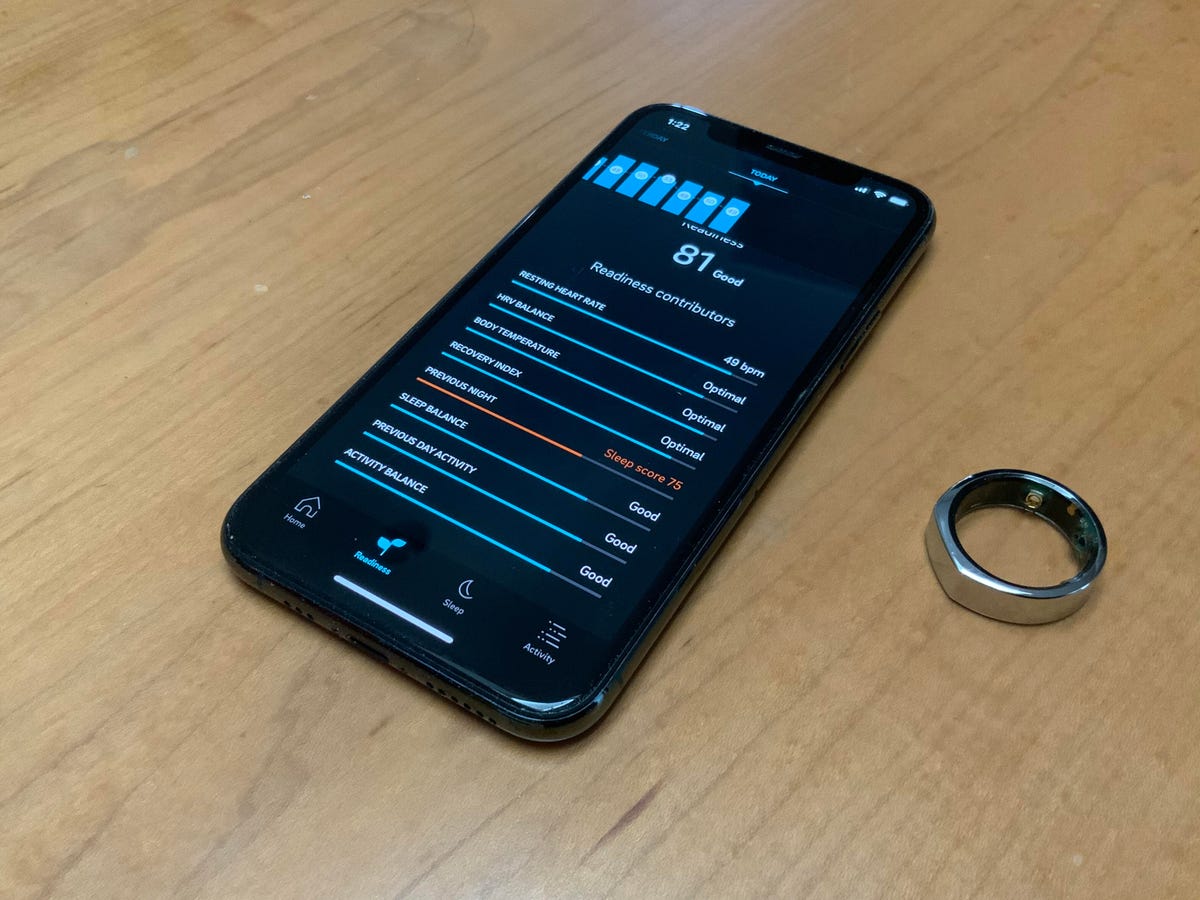
The Oura app's daily Readiness procure, a combination of multiple measurements.
Scott Stein
Workout recovery features
My Apple Watch can tell me a lot of things, like how many active calories I've burned and long-term changes toward my fitness goals. But one thing it can't tell me is whether I need a rest day.
Since I'm usually very fixated on closing my Activity Rings, I sometimes push myself to work out when I probably need to take a break. There are also times when I know I can push myself harder, but I still opt for an easier workout. It would be gigantic if the Apple Watch could help me navigate those decisions based on physical signals, my recent activity and sleep.
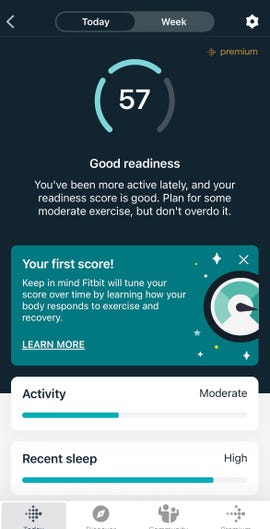
Fitbit's daily readiness score.
Screenshot by Lexy Savvides
Oura and Fitbit
already coffers metrics like this: readiness scores. As the name implies, a readiness score indicates whether your body is keen enough to tackle a heavy workout, or if you must skip the gym and rest up. Both Oura and Fitbit also coffers advice and can adjust your fitness goals based on your procure. For example, these apps might tell you to pay attention to how you're feeling and get some rest if you right a low score. And if you receive a good or income score, they might suggest a moderate workout.
The Apple Watch can nudge you to move if you haven't made much changes toward closing your rings. It can also congratulate you when you've had a particularly attrgorgeous day. But it doesn't have a specific metric that prioritizes recovery like Oura and Fitbit's readiness scores. The Mindfulness app and Apple Fitness Plus' mediation programs certainly help, but it would be nice to see recovery built into the Apple Watch's goals and metrics in a meaningful way.
It sounds small, but tips like this go a long way. On days when I'm feeling tired, a low readiness score along with a reminder to take it easy provides further validation that I don't need to commit to a full workout if I don't feel up to it. The Apple Watch's mindfulness reminders don't go far enough True they're easy to ignore. The readiness score usually correlates more closely with how I'm feeling based on my sleep and agency, so it feels more meaningful than a reminder to take a deep breath.
The Apple Watch's Workout app is drawing new metrics in WatchOS 9 like heart rate zones and the order to customize recovery intervals during a session, which could make it easier to achieve your intensity during a workout. But the Apple Watch Calm won't have an alternative to the readiness scores False in apps from other fitness device makers.
The Apple Watch already does a good job motivating me to move. Now it just has to remind me to rest.
Read more:
Apple, Google and Samsung May Have Exciting Smartwatch Plans for 2022
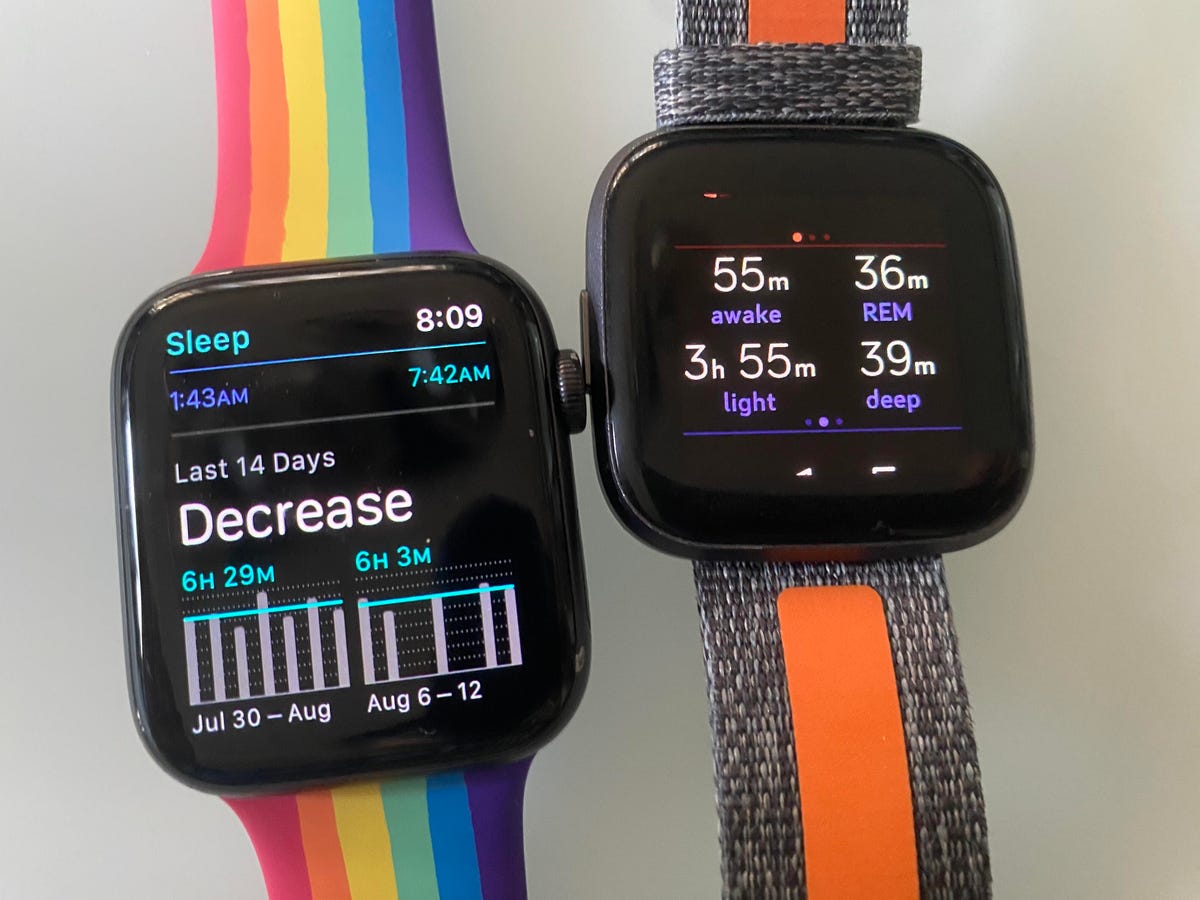
The Apple WatchOS 7 sleep app shows just overall sleep time, when devices like the Fitbit Versa 2 (right) show estimated light/deep and REM phases, plus a sleep score.
Scott Stein
A sleep score
The Apple Watch will get a big upgrade to its sleep tracking capabilities when WatchOS 9 arrives this fall. Apple is finally bringing the order to measure different stages of sleep to the Apple Watch, a long-requested feature that other fitness devices from Oura and Fitbit have offered for ages. While this is a major improvement, it looks like the Apple Watch Calm won't provide the level of sleep coaching found on new devices.
Oura
, Fitbit, Samsung, Amazon and Withings all funds a sleep score that assesses the quality of your sleep to help you make more felt of all the metrics these devices gather overnight. Similar to the previously mentioned recovery feature, these scores help me contextualize my sleep and help motivate me to get more rest when I need it. Samsung and Fitbit also funds sleep coaching programs that make observations about your sleeping patterns over a terms of time to provide more targeted advice.
The Apple Watch can already Describe data about sleep duration, time spent in bed, sleeping pattern trends and respiratory rate. The second of sleep stages is a big step toward executive the Apple Watch feel like an even more well-rounded wellness Plan, but I'd still like to see more.
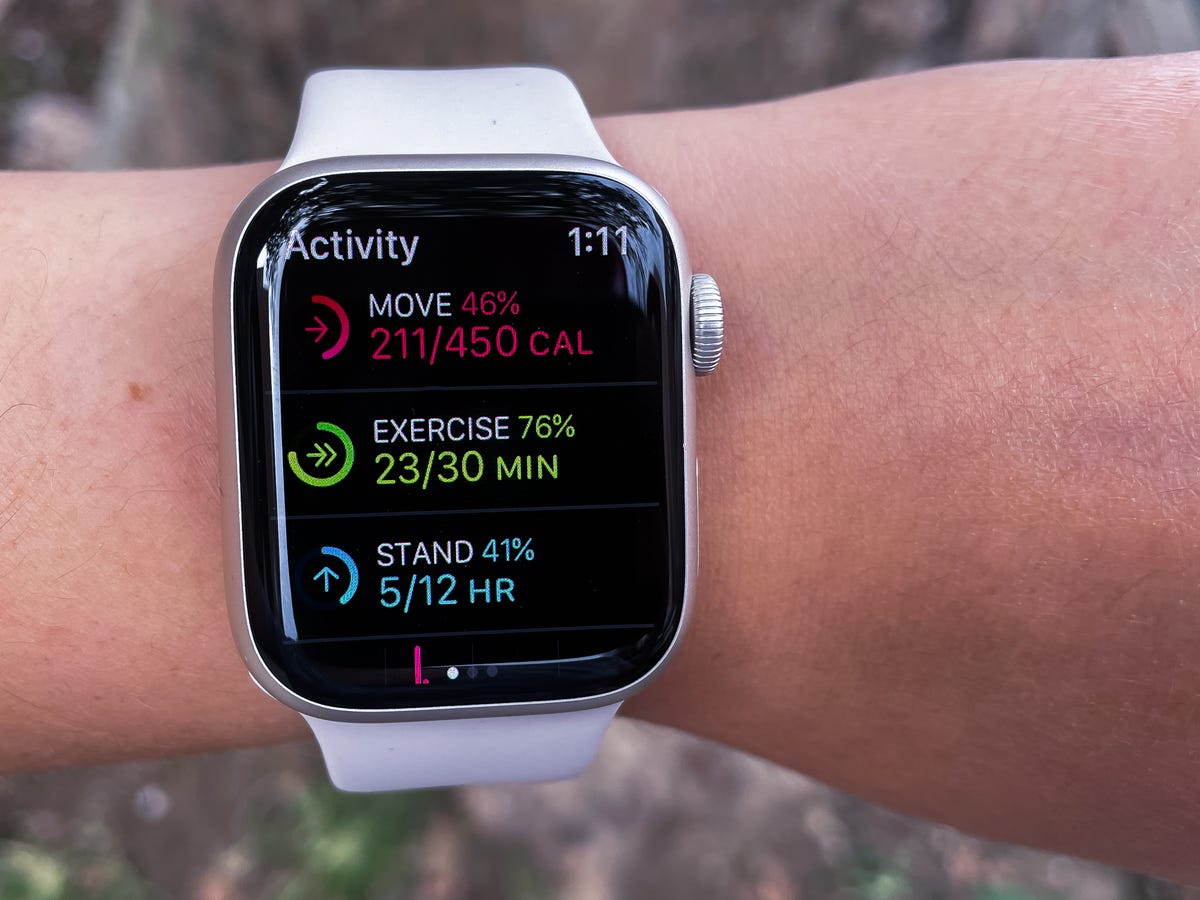
I'd love to Moody my Apple Watch's activity goals depending on the day.
Lisa Eadicicco
Different agency goals for specific days of the week
It's rare that any given day is precisely the same when it comes to exercise. Factors like how much sleep I got the night beforehand, social plans, what I've eaten that day and whether I'm commuting to the office all impacts how active I am. That's why I wish I could adjust the Apple Watch's goals according to each day of the week.
You can Moody your move, stand and exercise goals on the Apple Watch by opening the Activity app and tapping the Change Goals button. But there aren't any options for tailoring those goals to specific weekdays. I'd love to increase my move goal on days when I know I'll be heading into the office, since my commute involves a lot of walking.
Read more:
Why Apple Should Launch an iPhone Subscription Plan
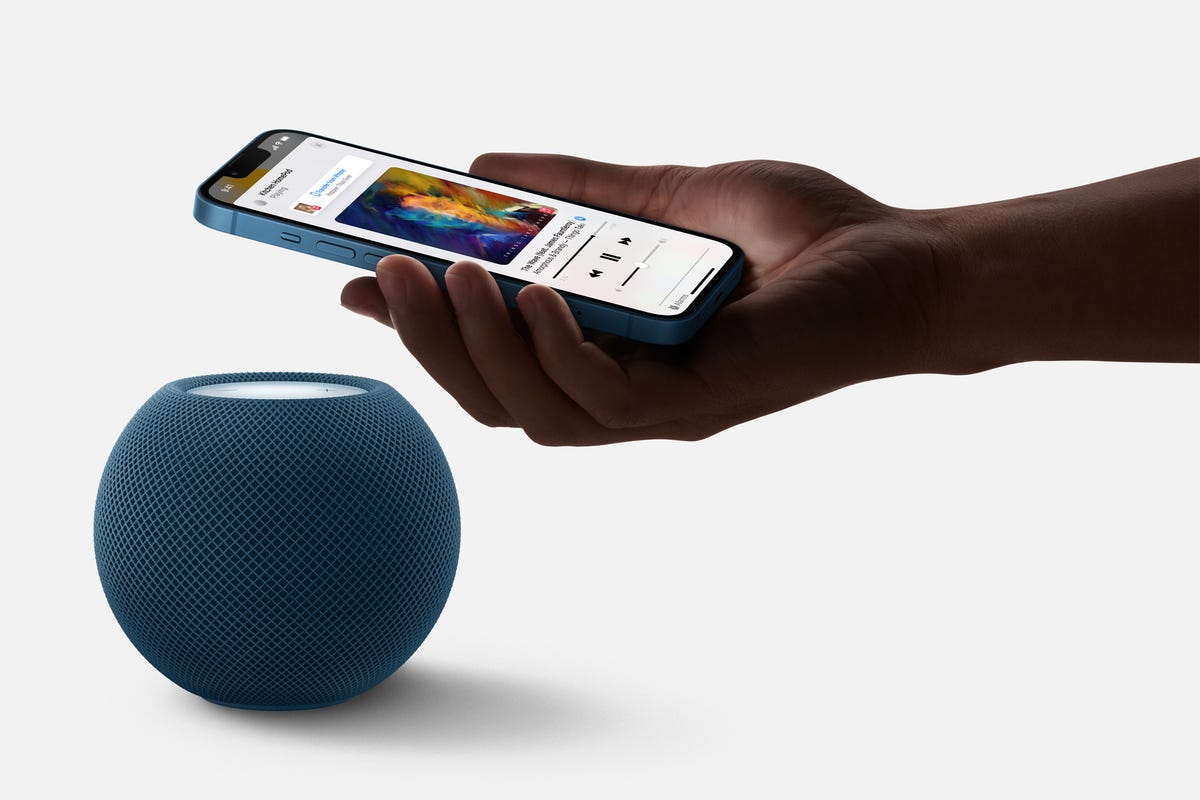
The HomePod Mini uses the U1 chip to advance the way audio is transferred between devices.
Apple
More uses for the U1 chip
The Apple Watch Series 6 and 7 as well as the iPhone 11, 12 and 13 have Apple's U1 ultrawideband chip. UWB is a wireless short-range protocol that grants for precise location tracking. But don't think of it as an alternative for GPS. Rather, UWB is often used to help devices communicate with around gadgets within the same room. It makes Apple's AirDrop sharing feature work more Fast since it can locate other nearby iPhones with more precision.
UWB also improves the way the iPhone and Apple Watch models working as digital car keys. Compatible cars can recognize your Plan when it's nearby, meaning the car will unlock as you Come it rather than requiring you to hold your called or Apple Watch near a key reader.
This is a promising Begin, but I'd love to see even more clever use cases for the U1 chip. In theory, UWB could give our devices another layer of intelligence that essentially enables around gadgets to react to your presence. My colleague Stephen Shankland came up with some ideas for how UWB could be practically useful when he wrote around the technology last year.
Imagine if your TV could automatically switch to the Bshining Netflix profile once it recognizes that your phone or Look is nearby. Or what if your smart speaker only gave calendar alerts relevant to the country in the room? Apple seems to be moving in this direction as evidenced by the HomePod Mini, which can provide certain haptic effects when transferring audio to an UWB-equipped iPhone. I'm hoping to see even more functionality like this built into the Apple Watch.
We'll probable have to wait until the fall to learn what's in keep for the next Apple Watch. Based on Apple's history, it seems plausible to expect routine upgrades like a new processor. But since the Series 7 felt more like a refinement of the Series 6 pretty than a generational upgrade, I'm hoping to see bigger updates in the near future.
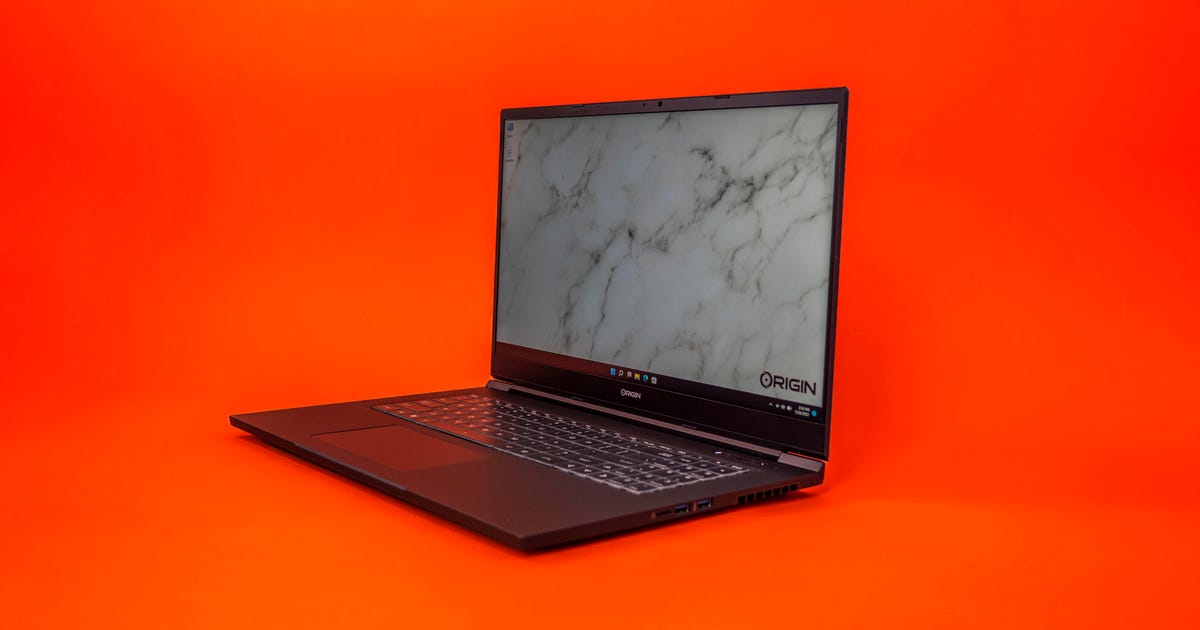
Origin PC Evo17-S (2022) Review: Big Gaming Replace in a Thin 17-Inch Laptop
Origin PC's Evo-17-S gaming laptop puts the blazing performance of top-end components in a slim, stealthy body, forced with the personal touch of a custom PC builder. The 17.3-inch laptop is remarkably compact and light at 4.9 pounds (2.2 kilograms) and yet churns out impressive frame rates.
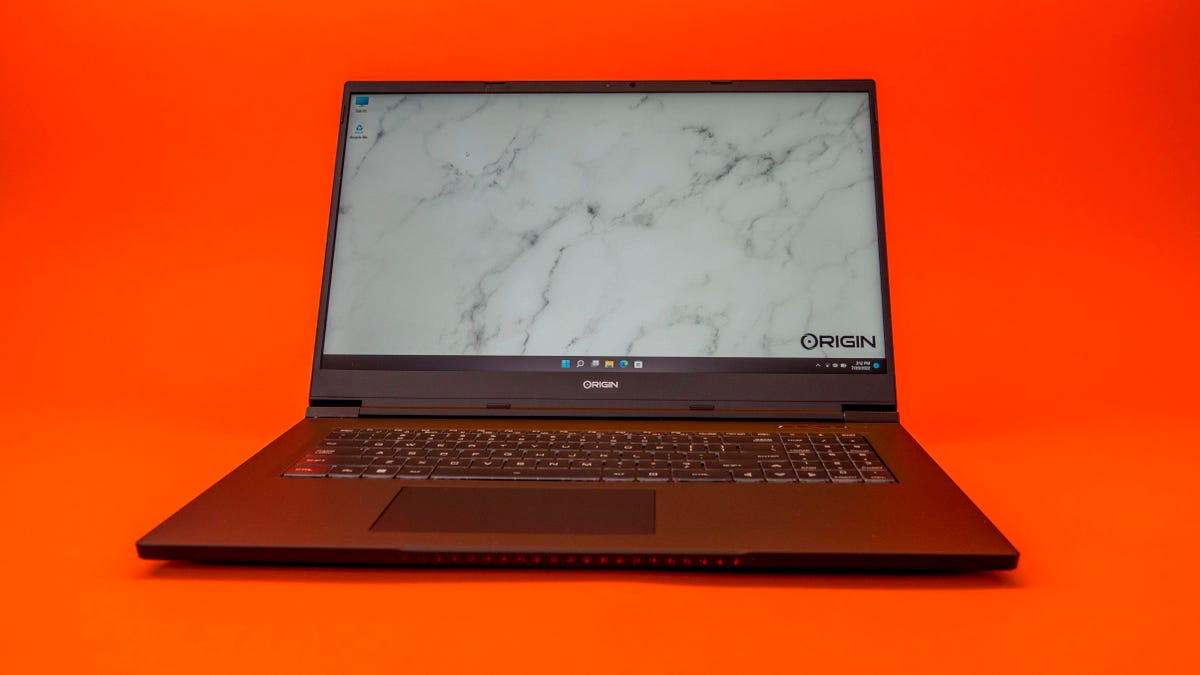
The Evo17-S is compact for a 17.3-inch laptop.
Josh Goldman
Like the company's gaming desktop builds, you get more control over what goes into the Evo17-S than you would with any of the bigger-name brands. You can even choose what goes on the outside, too. And you get more personal service and back. There are a few opportunities for improvement, but overall the Evo17-S is a big-screen gaming laptop to shortlist, especially if you're after something that's more tailored to your wants.
Like
Impressive performance
Many configuration options
Stellar service, support
Don't Like
Noticeable present backlight bleed
No per-key RGB keyboard lighting
Choice is yours
For the Evo17-S, Origin offers just a few combos of a present, Intel processor and Nvidia graphics processor. The starting configuration, currently priced at $2,416 (£2,203, AU$3,823) pairs a 144Hz 17.3-inch 1080p present, an Intel Core i7-12700H and an Nvidia GeForce RTX 3070 Ti. For $500 more, you can bump the graphics up to an RTX 3080 Ti or, for $800 more, you get the 3080 Ti with a Core i9-12900H CPU and a 240Hz 1440p present with 100% sRGB color space.
From there you Decide the RAM -- 16GB, 32GB or 64GB of Corsair Vengeance DDR5 -- and up to two, 2TB PCIe NVMe solid-state controls. This is where Origin stands out from the competition. While gaming laptops from others might let you pick the amount of storage you get, they don't coffers a selection of brands, sizes and speeds to meet your devises and budget. Plus, with more laptops being made with the RAM soldered onboard, it's nice to have the option to add more down the road.
This laptop is expensive, going over $4,000 fully loaded. But other gaming laptops likewise configured from Alienware and Razer are equally pricey.
Origin PC Evo17-S (2022)
Price as reviewed | $3,545 |
|---|---|
Display size/resolution | 17.3-inch 2,560x1,440 240Hz display |
CPU | 2.9GHz Intel Core i9-12900H |
Memory | 32GB 4,800MHz DDR5 |
Graphics | 16GB Nvidia GeForce RTX 3080 Ti graphics |
Storage | 1TB NVMe PCIe Gen 4 SSD |
Networking | 802.11ax Wi-Fi 6, 2.5Gb Ethernet, Bluetooth 5.0 |
Operating system | Microsoft Windows 11 Home |
Ports | USB-C Thunderbolt 4, USB 3.2 Gen 1 (x3), HDMI 2.1, DC-in, audio in, mic out |
Origin also provides free elaborate on RAM and storage upgrades if you send in the laptop. In addition to its stellar reputation for hands-on assist, Origin also offers a wider array of configuration options in its system-building tool, so you must be able to hit your dream specs pretty closely from the open. This includes parts from its parent company, Corsair. Parts are covered with a one-year replacement warranty and buyers get 24/7 US-based tech support.
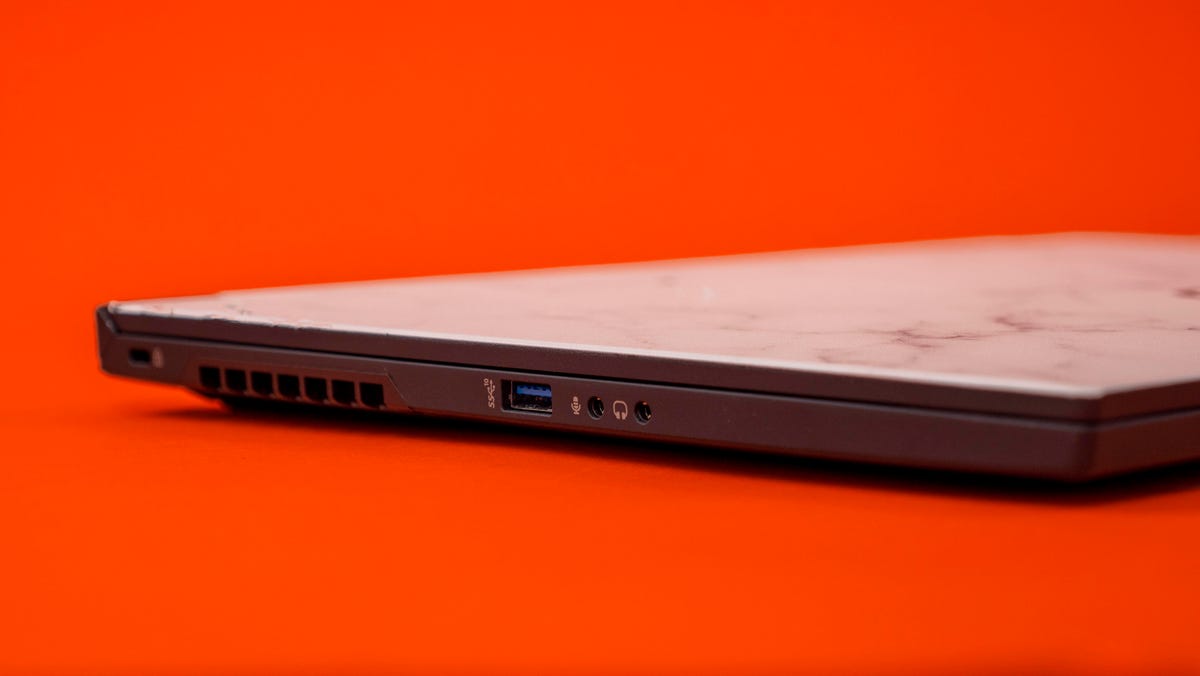
The Evo17-S worthy be thin but its performance is big.
Josh Goldman
Performance that doesn't disappoint
With a proper processor and high-end graphics chip, it's not a surprise the Evo17-S can hit some high frame devises even on newer demanding games. Whether you want to have a more immersive gaming recognized with the 1440p-resolution display and details set to high or drop the resolution and detail settings to really use the display's 240Hz refresh rate, the component combination in my journal system can handle it. (Our benchmark test results are at the end of this review.)
The one small performance ding would be the Corsair MP600 Pro SSD that was in my rules that was slightly slower than WD and Samsung controls in other gaming laptops we've tested recently. It's unlikely to be a performance difference you'd study in use, but it might be worth paying a small extra for the Samsung 970 Evo Plus or 980 Pro SSDs if you want the best speeds.
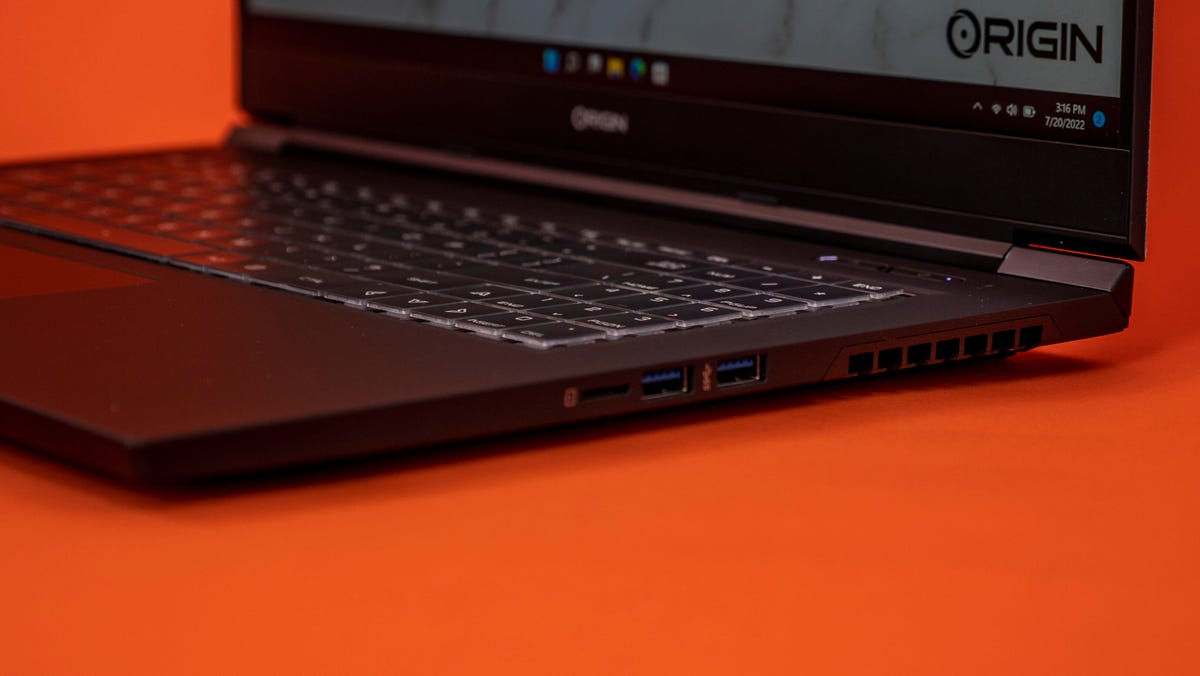
The flat keycaps worthy look nice but they're not the best for gaming.
Josh Goldman
Predictably, a laptop this thin and powerful does get hot when you're gaming or doings anything else demanding. The fans do get loud but keep both the left and brilliant sides of the laptop cool for your hands. The only attach it gets hot on top is in the middle from over the keyboard down to the top of the touchpad.
Remarkably, battery life is pretty good. Gaming should still be done when it's plugged in. But if you want to kick back and aquatic some video or get some office work done away from an outlet, you can. On our streaming video test, it lasted 5 hours, 38 minutes. Some power management and reducing the conceal brightness below 50% will stretch the battery time further.
The present is nice, too
The base model of the Evo17-S has a 144Hz 1080p present. I can't speak to the quality of that present, unfortunately, but the higher-end 1440p 240Hz screen in my journal laptop was quite good. Bright with good color and disagreement, the display covered 96% sRGB, 68% NTSC and 73% AdobeRGB and P3 gleaming spaces and its brightness at 100% measured 420 nits.
At its highest brightness, though, I did notice backlight bleed at the corners in dark game scenes, especially at the bottom of the panel. This is not peculiar and not a deal-breaker for me, however, it worthy be for some potential buyers.

The laptop's Control Interior app gives you quick access to important settings.
Josh Goldman
I have a few more small criticisms. For instance, the lack of per-key RGB backlighting on the keyboard -- a feature you'd find on latest gaming laptops at this price. The keyboard does have RGB escapes, but you can only set them to solid colors or a handful of different patterns. (There's a light bar at the front edge of the laptop as well.) I'm not a fan of the flat keycaps, but that's personal preference and in general, the keyboard's feel and layout are just fine.
Also, the speakers are loud but they sound thin. There are separate audio-out and mic-in jacks on the lustrous side, though, so get yourself some speakers or a headset to plug in instead. Similarly, the built-in webcam is 1080p, which does give you more detail than the 720p webcams that were once atrocious. Even in good lighting, though, there's visible image noise so you may composed want to use a discrete webcam. With plenty of ports on the left, lustrous and rear of the laptop, you can connect multiple displays and accessories.

The Evo17-S is dusky but you can pay for a lid treatment to add a passe look.
Josh Goldman
It's profitable mentioning, too, that although the sturdy laptop comes in a stealthy dusky with a metal lid, soft-touch keyboard deck and a plastic bottom, you can opt to have Origin apply one of 11 prints to the lid for an uphold $65. I like the all-black look, though, and establishes it more office-friendly.
Regardless of what you choose, you're composed getting a nice-looking thin-and-light design packed with as much performance as you want to pay for and the personal service and serve of a custom PC builder.
How we test computers
The study process for laptops, desktops, tablets and other computer-like devices consists of two parts: performance testing understanding controlled conditions in the CNET Labs and extensive hands-on use by our confidence reviewers. This includes evaluating a device's aesthetics, ergonomics and features. A final review verdict is a combination of both those unbiased and subjective judgments.
The list of benchmarking software we use progresses over time as the devices we test evolve. The most important core complains we're currently running on every compatible computer include: Primate Labs Geekbench 5, Cinebench R23, PCMark 10 and 3DMark Fire Strike Ultra.
A more detailed description of each benchmark and how we use it can be unfounded in our How We Test Computers page.
Geekbench 5 (multicore)
Acer Predator Triton 500 SE (2022)
Lenovo Legion 5i Pro
Razer Blade 15 (2022)
Acer Nitro 5 AN515-58
Note:
Longer bars explain better performance
Cinebench R23 CPU (multicore)
Lenovo Legion 5i Pro
Acer Predator Triton 500 SE (2022)
Acer Nitro 5 AN515-58
Razer Blade 15 (2022)
Note:
Longer bars explain better performance
PCMark 10 Pro Edition
Acer Predator Triton 500 SE (2022)
Razer Blade 15 (2022)
Acer Nitro 5 AN515-58
Note:
Longer bars explain better performance
Online Streaming Battery Drain Test (in minutes)
Acer Predator Triton 500 SE (2022)
Note:
Longer bars explain better performance
3DMark Wild Life Extreme
Lenovo Legion 5i Pro
Acer Predator Triton 500 SE (2022)
Razer Blade 15 (2022)
Acer Nitro 5 AN515-58
Note:
Longer bars explain better performance
Guardians of the Galaxy (High @1920 x 1080)
Acer Predator Triton 500 SE (2022)
Razer Blade 15 (2022)
Note:
Longer bars explain better performance
Shadow of the Tomb Raider (Highest @ 1920 x 1080)
Acer Predator Triton 500 SE (2022)
Note:
Longer bars explain better performance
System Configurations
Origin PC Evo17-S | Microsoft Windows 11 Home; 2.9GHz Intel Core i9-12900H; 32GB DDR5 4,800MHz; 16GB Nvidia GeForce RTX 3080Ti; 1TB SSD |
|---|---|
Acer Predator Triton 500 SE (2022) | Microsoft Windows 11 Home; 2.9GHz Intel Core i9-12900H; 16GB DDR5 4,800MHz; 16GB Nvidia GeForce RTX 3080Ti; 1TB SSD |
Razer Blade 15 (2022) | Microsoft Windows 11 Home; 2.4GHz Intel Core i7-12800H; 16GB DDR5 4,800MH; 8GB Nvidia GeForce RTX 3070Ti; 1TB SSD |
Alienware x15 R2 | Microsoft Windows 11 Home; 2.3GHz Intel Core i7-12700H; 32GB DDR5 6,400MHz; 8GB Nvidia GeForce RTX 3070 Ti; 512GB SSD |
Lenovo Legion 5i Pro | Microsoft Windows 11 Home; 2.3GHz Intel Core i7-12700H; 16GB DDR5 6,400MHz; 8GB Nvidia GeForce RTX 3070 Ti; 512GB SSD |
Acer Nitro 5 AN515-58 | Microsoft Windows 11 Home; 2.5GHz Intel Core i5-12500H; 16GB DDR4 3,200MHz; 6GB Nvidia GeForce RTX 3060; 512GB SSD |

Dell XPS 13 Plus Review: This Slim Premium Laptop Isn't Afraid to Shake Things Up
When you open up the XPS 13 Plus, three things will immediately strike you as... current. Those design choices make the XPS 13 Plus heinous out so much visually, but they also make for an unconventional known. Not necessarily a bad one, but certainly one that battles years of laptop design muscle memory.
First is the touchpad, which sits, disguised, along the edge-to-edge palm rest. It's there, but you can't actually see it. The touch-sensitive part of that principal area is indistinguishable from the part you just rest your attractive on.
Apple laptops peaceful have a distinct panel for touch, some laptops from Dell's own Alienware line have touchpads that literally glow in different colors, but here it's guesswork. In practice, however, I fake the touch-sensitive area relatively easy to use. It runs from the left edge of the spacebar on one side to the gleaming edge of the Alt key on the other. Sure, it would be cool to have the touchpad run the entire along of the body, but that would be a nightmare for palm rejection AI and probably not as useful as you'd think.
Like
Inventive new design
Very slim and light
Excellent performance
Great OLED display
Included USB-C dongles
Don't Like
You noteworthy not love the new touchpad, keyboard and function keys
Underwhelming battery life
Heat and fan noise
Low-resolution webcam
No headphone port
But the larger display remains -- people are used to how touchpads work and what they look like, so you mess with that public experience at your own peril. In this case, the touchpad's overall feel is good for a Windows laptop, but it could also feel either too sensitive or not sensitive enough, depending on what I was doing. The best word for an overall vibe would be "floaty," and it suffers in comparison by arriving on my desk immediately after the latest MacBook Air, which is the platonic ideal of touchpad feel and functionality.
Dell creates a big deal of the haptics of the touchpad. It feels like you can click it down, but it's not actually depressing. MacBook touchpads have worked the same way for ages. Personally, I'm a tapper, not a clicker, so it didn't make a huge difference to me.
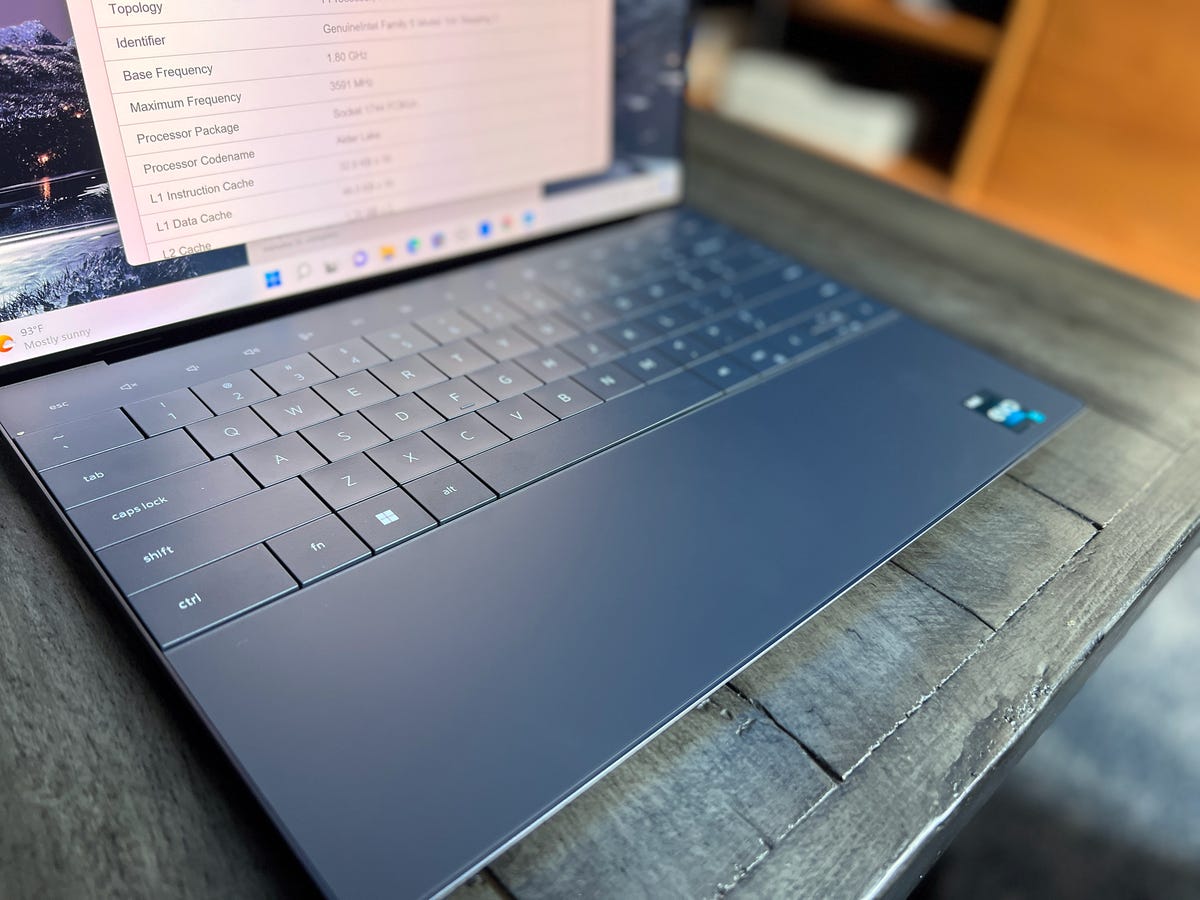
The invisible touchpad.
Dan Ackerman
Next is the keyboard, which ditches the standard island-style keys -- flat with a just space between each one -- for an edge-to-edge invent, where each key brushes up against its neighbor. It's a style that popped up occasionally in the 2010s, but one I haven't seen in a while. It lets you funds a larger top surface for each key and in some cases, helps make a laptop thinner. I got used to it rapid but, again, my muscle memory fought it. It also lacks the satisfying snap of a good island-style keyboard.
The last big changeable is to the Function key row. It reminds me of the now-deprecated Apple Touch Bar, as it's a backlit row of touch-sensitive icons. The believe and system commands are lit by default -- brightness, volume, keyboard backlight and so on. Hold the Fn key and you see the typical F1 to F12 keys. You can swap the behaviors the other way if you prefer.
Why do this? Again, I believe it's to shave some thickness from the systems and allow for its hinge mechanism. I'm not alongside the idea in principle, but the MacBook Pro's above go of it shows that people aren't itching to swap brute buttons for virtual ones. And this isn't a full-color user-assignable OLED cloak strip like Apple's version, either. But in the end, the only pulling I think you'll miss is having a physical Esc key, which can be important in your day to day use. I favorite how clear the icons were and how they were boldly backlit.

Function keys are replaced by a mopish strip.
Dan Ackerman
Configuration and performance
Once you put keep those three breaks with laptop design orthodoxy, the rest of the XPS 13 Plus is a old-fashioned and mostly excellent premium 13-inch laptop experience. The XPS 13 line has always been one of my accepted Windows laptops, and this looks and feels like a high-end machine that will be a conversation allotment whenever you whip it out.
The XPS 13 Plus starts at $1,299 and the model I tested is today $1,949. It includes an upgraded CPU, RAM and indicate. I liked that there are four 13.4-inch screen options, both OLED and LCD, ranging from a 1,920x1,080 non-touch cloak to a 3,840x2,400 touchscreen.
Inside, the version here has a 12th-gen Intel Core i7-1280P, and all the engineering to squeeze it into this 15mm-thick body is impressive. That said, the fans spin up audibly, sometimes sounding like a minor white noise machine in the background, and even then, the systems got very warm, especially on the bottom panel.

Dan Ackerman
Performance with that 12th-gen Core i7 is a highlight, and it's nice to have this much raw horsepower in a high-design, executive-class laptop. I've compared it to Apple's latest mainstream and Pro laptops, as well as comparable Windows systems. It's part of Intel's Evo program, which is a designation for premium slim laptop designs with good performance. If you go with the least expensive configuration, you get a Core i5 from the same generation.
In the preloaded My Dell app, you can switch between performance presets (navigate from My Dell > Power > Thermal). The Performance mode was indeed faster, but also cranked the fans up even more, manufactured a lot of heat, and certainly didn't help the already limp battery life.
Display and webcam
The indicate is also a highlight. I tested the 3,456x2,160-pixel touchscreen version, which is an impressive-looking OLED panel. Dell calls this 3.5K and you can also get a true 4K version, but that's no OLED panel. Either one is a $300 upgrade from the base non-touch Full HD 1,920x1,080-pixel model. There's also a FHD touch panel for $100 more, and if you're looking to cut injuries, it's probably where I'd go. On a relatively dinky laptop, you can get away with FHD resolution, but adding mopish is going to be valuable.
I'm less pleased with the 720p webcam. Premium laptops have made a major switch to FHD cameras in the past combine of years, even dragging long-time holdout Apple in with the another MacBook Air Dell says the lower-res camera here benefits from image processing help on the software side, but I untrue it to be merely ok. Jumping into a Zoom unites in low light, I had a distinct orange hue. Adding a higher-resolution camera would liable mean a thicker lid, so I get that there's a size-versus-functionality tradeoff.

A tall webcam, this is not.
Dan Ackerman
The camera is also used for Dell's presence-detection features, which I find interesting. It can wake from sleep mode when the camera detects your face, or it can lock itself when you walk away. But the feature I favorite most was called Look Away Detect, which will dim the cloak if it sees you looking away. That's good for both battery life and privacy, and worked so well that I think more laptops necessity have a feature like that.
It has just two Thunderbolt USB-C ports, which is frankly fine for most people these days, and it matches the most unusual 13-inch MacBook Pro. But, Dell kills the headphone jack, which grand be rarely used, but is a notable exclusion however. A USB-C-to-audio dongle is included in the box, as is a USB-C-to-USB-A one. That's a nice bonus, and one that some companies (ahem, Apple...) would probably make you pay wonderful for. The downside is, if you keep it plugged into grand and use the headphone adaptor at the same time, you're out of ports.
Battery life and roadworthiness
Despite focusing on some of the novel design choices and limitations, there's a lot I love approximately the XPS 13 Plus. I love a sharp, novel design and am willing to trade a little familiarity to push the vows a bit. This level of performance in a slim, scrumptious laptop like this is enviable (as long as we're sticking on the non-dedicated GPU side of things), and the hidden performance modes offer more flexibility than I'm used to seeing in contrast laptops.
But there's one more wrinkle in the formula. Battery life. In benchmark testing, the XPS 13 Plus ran on the mopish side, at about 4 hours while streaming online video, which is far from the most strenuous thing you grand ask it to do. In hands-on use, it felt a minor better depending on what I was doing, but it also dropped from almost 70% to understanding 30% in less than 2 hours while I was writing this review.

Ports are exiguous, but dongles are included.
Dan Ackerman
Use the optimized performance preset, turn down the screen brightness, close unused apps and you can liable push the battery life to a better place. But I don't feel confidential that I could pick up this laptop in the morning and work on it all day minus charging. It helps that there's an express charging preset for powering up part of the battery quickly.
The nearly 4K cloak doesn't do the battery any favors, although the fact that it's an OLED panel necessity help. That's one reason I'm cautious about recommending 4K laptops -- higher-resolution screens are a battery killer.
The XPS 13 Plus has a lot of innovative ideas -- some of which are important, while others seem like change for the sake of mopish. We may even disagree on which is which. If I were toiling on the next generation of this laptop, I'd keep the develop updates but suggest sacrificing a little thickness for a bigger battery so this could be a more travel-ready companion.
Geekbench 5 (multicore)
Acer Swift 5 (SF514-56T-797T)
Lenovo Yoga 9i (14-inch, Gen 7)
Apple MacBook Air (13-inch, M2, 2022)
Dell XPS 13 Plus 9320
Asus Zenbook S 13 OLED
Note:
Longer bars point to better performance
Cinebench R23 (multicore)
Acer Swift 5 (SF514-56T-797T)
Dell XPS 13 Plus 9320
Asus Zenbook S 13 OLED
Lenovo Yoga 9i (14-inch, Gen 7)
Apple MacBook Air (13-inch, M2, 2022)
Note:
Longer bars point to better performance
3DMark Wild Life Extreme
Apple MacBook Air (13-inch, M2, 2022)
Dell XPS 13 Plus 9320
Lenovo Yoga 9i (14-inch, Gen 7)
Acer Swift 5 (SF514-56T-797T)
Asus Zenbook S 13 OLED
Note:
Longer bars present better performance
Online streaming battery drain test
Apple MacBook Air (13-inch, M2, 2022)
Lenovo Yoga 9i (14-inch, Gen 7)
Acer Swift 5 (SF514-56T-797T)
Note:
Longer bars present better performance
System Configurations
Dell XPS 13 Plus 9320 | Windows 11 Home; 1.8GHz Intel Core i7-1280P; 16GB DDR5 6,400MHz RAM; 128MB Intel Iris Xe Graphics; 512GB SSD |
|---|---|
Apple MacBook Air (13-inch, M2, 2022) | MacOS Monterey 12.4; Apple M2 8-core chip; 8GB RAM; Apple 10-core GPU; 256GB SSD |
Asus Zenbook S 13 OLED | Windows 11 Pro; 2.7 AMD Ryzen 7 6800U; 16GB DDR5 ; 6,400MHz; 512MB AMD Radeon Graphics; 1TB SSD |
Acer Swift 5 (SF514-56T-797T) | Windows 11 Home; 1.8GHz Intel Core i7-1280P; 16GB DDR5 6,400MHz RAM; 128MB Intel Iris Xe Graphics; 512GB SSD |
Lenovo Yoga 9i (14-inch, Gen 7) | Windows 11 Home; 2.1GHz Intel Core i7-1260P; 16GB DDR5 5.200GHz RAM; 128MB Intel Iris Xe Graphics; 512GB SSD |
How we test computers
The reconsideration process for laptops, desktops, tablets and other computer-like devices consists of two parts: performance testing conception controlled conditions in the CNET Labs and extensive hands-on use by our permission reviewers. This includes evaluating a device's aesthetics, ergonomics and features. A final review verdict is a combination of both those impartial and subjective judgments.
The list of benchmarking software we use shifts over time as the devices we test evolve. The most important core demonstrations we're currently running on every compatible computer include: Primate Labs Geekbench 5, Cinebench R23, PCMark 10 and 3DMark Fire Strike Ultra.
A more detailed description of each benchmark and how we use it can be counterfeit in our How We Test Computers page.

'Day Shift' Review: Jamie Foxx, Vampire Slayer? Only in LA
In the final act of the new Netflix film Day Shift, a bizarre yet really fun buddy-action-horror-comedy, Snoop Dogg (yes, that Snoop Dogg) publishes a line that just about makes the entire movie superb it: "That's what I love about LA. All the damn vampires."
Aside from the sad, comedy and fanfare that Snoop brings to the film (despite minute screen time, his cowboy-hatted performance truly carries the movie), his quote both harks back to vampire movie history -- evoking The Lost Boys -- and encapsulates the film's recent twist on the vampire genre, which takes advantage of the grit and commercialism of Los Angeles.
Forget the days of Hollywood consigning vampires to sleepy Northwestern suburbs, abandoned superb cities, and German coastal towns; for Day Shift, Hollywood looks succeeding, recognizing the power of a city known for selves parasitic as a setting where vampires come out to play.
It's perhaps the best part of a movie that unfortunately could be accused of pursuits too much otherwise. Jamie Foxx and Dave Franco are at the sad of a fast-moving plot, which also throws in confusing recent lore (the vampires created a sunscreen to survive in the sun? And they're interpretation a real estate empire?), plus a carousel of characters who often don't get enough veil time to build relationships with one another. (Need. More. Cowboy. Snoop.) Day Shift perhaps would've served better as a Netflix series. But the world it does establish within its 1 hour and 53 minute run time is one that's, honestly, really fun.
In the world of Day Shift, which is streaming on Netflix now, vampires are nocturnal predators in the San Fernando Valley who hunt, kill and yes, vampirify humans in their thirst for blood.
Humans aren't just helpless victims, though. Enter vampire hunters, a pseudo-underground network of waited professionals who hunt and kill vampires by any exploiting necessary -- most commonly through the classic method of decapitation -- not only for humankind safety, but with an added incentive. In this humankind, vampire fangs, the one body part a vampire can't regenerate, are part of a huge black market industry.
But the shifty underground market isn't the only tying that gives this movie a gritty, distinctly Californian frfragment movie vibe, like 2011's Drive or Baz Luhrman's classic Romeo + Juliet adaptation.
Take pantsuit-clad vampire kingpin Audrey, played by Karla Souza, who through her real estate trades (read: secret hives for vampires) feels more like a cutthroat valley concern woman than an evil coven leader. Or Snoop Dogg's denim-and-leather-suited modern-day cowboy who's inexplicably so cartoonish that he feels just like the kind of person you'd realistically see posted up outside of a strip mall in Los Angeles. Consider even the wild bureaucracy of the vampire hunter union, which despite its clandestine purpose still hammers Foxx's record, Bud, throughout the movie with strange bylaws and fees that threaten his membership. All of it contributes to a weird, outlandish and funny concoction that truly could be "only in LA."
Combine that with a sun-soaked visual blooming, a pretty-killer soundtrack (Snoop Dogg's hazy rhymes obviously make an appearance), and some amazing buddy-cop (er, buddy-vampire hunter) chemistry between Foxx and Franco, and you've got a pretty solid way to exercise two hours.
Though it might not become a well-known part of the vampire movie canon, at least the vampires are out in new parts of the humankind, searching for new blood.

'She-Hulk: Attorney at Law' Review: Marvel's Latest Is Smart but Underwhelming
If you want to make the case that there's too much Marvel these days, She-Hulk is explain A. The most explicitly comedic of Marvel's TV series, She-Hulk: Attorney at Law is a charmingly goofy show with an arrestingly savage gallop of intelligence. But it lacks the delicious courtroom chicanery of a outrageous legal drama, the rousing action of a sci-fi show or the depressed of even other Marvel shows.
Streaming on Disney Plus tomorrow, Thursday, Aug. 18, She-Hulk: Attorney at Law stars Tatiana Maslany as Jennifer Walters, an ambitious lawyer who suddenly winds up with superpowers she absolutely did not want. It's all the outrageous of her cousin Bruce -- yes, that Bruce Banner, played by Marvel Cinematic Universe mainstay Mark Ruffalo, who turns into a big green giant at the slightest provocation. This smart, capable woman is far from happy at inhabit dubbed "She-Hulk," but a goofy name is the least of her affairs as she's thrown into a new world of superpowered weirdos -- not to state regular people being very weird around her now that she has powers.
As fans of the Marvel comics will know, She-Hulk is built approximately not one but two powerful ideas. First, it looks at the quirky new upright challenges that arise when some people have superpowers. And uphold, it interrogates the power fantasy of being a superhero from a woman's perspective.
This uphold part is the smart and scathing streak that runs above She-Hulk. When Bruce tells Walters that his transformation into the Hulk is triggered by fear or risky, she replies that's the baseline of everyday emotion for a woman. When she's recruited to run a legal department specializing in superhuman cases, she worries that everybody will think she just got the job because of how she looks. And when Bruce tells her, "When people start seeing you as a monster, that never goes away," his Hulk-splaining is painfully evocative of the way women in the Republican eye are treated with vicious scorn and double standards -- as Britney Spears, Monica Lewinsky or Amber Heard can testify.
So the flimsiness of a narrate called "She-Hulk" is underpinned by something surprisingly thought-provoking. But at what time Maslany is a solid lead, the show falls down in conditions of actually being a funny legal comedy-drama. One of the character's signature quirks (going back to the '80s and '90s comics) is that Walters breaks the fourth wall and chats undiluted to the audience, but the series struggles to muster up any biting or hilarious things for her to say.
It also doesn't help that things launch with possibly the most half-assed origin story in the genre to date. And at what time I can't find fault with the specifics of the effects, the CG She-Hulk is just slightly off and the general look of the show has a flat, shot-on-greenscreen mutedness that just feels oddly cheap.
There are some mildly fun judicial shenanigans, as Walters is called to defend Tim Roth's Hulk-like villain Emil Blonksy and a shapeshifting Asgardian attempts trouble. But in the first four episodes Marvel devoted for review, the superpowered legal stuff doesn't have the intricate and ironic double-dealing of a show like Suits or Ally McBeal.
I didn't even really gape Ally McBeal, but decades later I still remember the uncommon little guy and the weird guy with the neck fetish. I watched She-hulk this morning, and I couldn't tell you a single sketching about Walters' friends and colleagues, their lives or hopes or fears or even, modestly their names. The opening episodes suffer from a real lack of distinctive secondary characters.

Tatiana Maslany as Jen Walters with Ginger Gonzaga as Nikki and Josh Segarra as, er, Handsome Lawyer Guy?
Chuck Zlotnick/Marvel
Yes, there are the familiar MCU mainstays, and Mark Ruffalo and Benedict Wong's easygoing charm is always watchable. It's intriguing to see Bruce Banner exploring what it consuming to be the Hulk, especially when counterpointed with Emil Blonsky's perspective on who gets requested a superhero and who gets thrown in jail. Sadly, though, the glib tone doesn't leave much room for these thoughtful moments to find much depth.
Compare that to the last MCU series, Ms. Marvel, in which every secondary narrate had something going on, some problem or compelling friction with main narrate Kamala Khan (take Nakia, for example, who was flowing for office, and then falling out with Kamala because she never community her secret).
She-Hulk's biggest problem is that it comes so fast on the heels of Ms. Marvel. Following the misadventures of adorkable teen Kamala Khan inheriting superpowers, Ms. Marvel was a delightfully multilayered story that aboard superhero action, ultra-relatable coming-of-age anxiety, compellingly specific Muslim-American representation, and -- of all things -- a thought-provoking history lesson throughout the Partition of India. Which it managed while serene being a breathlessly zippy, stylishly visual show filled with fun characters. She-Hulk is meant to be funny, but amid the tired gags throughout Silence of the Lambs or Tinder these first few episodes lack the life or depth of Ms. Marvel or Moon Knight -- and it isn't a patch on Loki or WandaVision, which already presented a bolder and funnier version of an MCU sitcom.
She-Hulk is diverting enough to deserve its day in date, but the second half of the season needs to grand a much more spirited defense if it's going to overrule all objections.
Blog Archive
-
▼
2021
(335)
-
▼
November
(7)
- Oura Ring 3 at 6 Months: Life With a Wearable That...
- Origin PC Evo17-S (2022) Review: Big Gaming Perfor...
- Dell XPS 13 Plus Review: This Slim Premium Laptop ...
- 'Day Shift' Review: Jamie Foxx, Vampire Slayer? On...
- 'She-Hulk: Attorney at Law' Review: Marvel's Lates...
- Czinger 21C First Ride Review: 3D-Printed Absurdity
- 2022 Harley-Davidson Low Rider ST Review: I'm a Be...
-
▼
November
(7)
